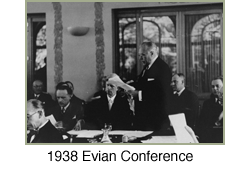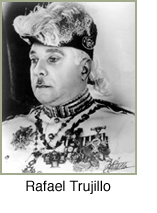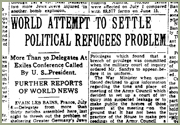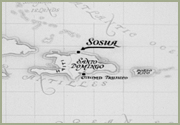|

Founded in 1938 as a haven for Jews escaping Nazi persecution, Sosua was an isolated settlement on the coast of the Dominican Republic that offered refuge to approximately 800 hundred German, Austrian and Polish Jews from 1940 - 1945.
 The proposal to settle Jews in Sosua emerged from the 1938 Evian Conference, convened by Franklin Roosevelt in response to the growing Jewish refugee crisis in Europe. Among the 39 nations attending, the Dominican dictator, Rafael Trujillo was the only one to come forward with an offer to accept one hundred thousand Jewish refugees. Trujillo's offer was an especially generous in relation to the general population as there were - all told - about only 1.6 million people living in the Dominican Republic at that time.
The proposal to settle Jews in Sosua emerged from the 1938 Evian Conference, convened by Franklin Roosevelt in response to the growing Jewish refugee crisis in Europe. Among the 39 nations attending, the Dominican dictator, Rafael Trujillo was the only one to come forward with an offer to accept one hundred thousand Jewish refugees. Trujillo's offer was an especially generous in relation to the general population as there were - all told - about only 1.6 million people living in the Dominican Republic at that time.
A murderous and racist dictator, Trujillo's offer to rescue Jews stemmed from his desire to improve his international reputation after the "Parsley Massacre" of 1937 where an estimated 20,000 Haitians were slaughtered at the Haitian/Dominican border. (It is called the "Parsley Massacre" because the Haitians and the Dominicans were so blended that their ethnicity was determined by how one pronounced the Spanish word for ‘parsley'. The Haitians who couldn't roll their "r's" in Spanish were killed.)
 In addition to redeeming his image, Trujillo was also said to be interested in "whitening" the general population of the DR. While the entire world was evolving toward restrictive immigration policies and created barriers against Jewish refugees, the Dominican Republic represented a rare exception. Still, racism was also an underlying principle for Dominican immigration policy, but Jews, in this instance, "passed" the fictitious color line and were welcomed on the condition that they become agricultural workers. The Joint Distribution Committee, an American Jewish organization, created a the Dominican Republic Settlement Association (DORSA) and funded it to purchase 26,000 acres of an abandoned banana plantation in Sosua.
In addition to redeeming his image, Trujillo was also said to be interested in "whitening" the general population of the DR. While the entire world was evolving toward restrictive immigration policies and created barriers against Jewish refugees, the Dominican Republic represented a rare exception. Still, racism was also an underlying principle for Dominican immigration policy, but Jews, in this instance, "passed" the fictitious color line and were welcomed on the condition that they become agricultural workers. The Joint Distribution Committee, an American Jewish organization, created a the Dominican Republic Settlement Association (DORSA) and funded it to purchase 26,000 acres of an abandoned banana plantation in Sosua.
Initially, the settlement struggled. The settlers needed a period of adjustment to the semi-tropical climate of the island. Tomatoes, the first crop chosen for commercial exploitation, proved unattractive to the local Dominican population. The colony appeared headed for disintegration. DORSA imported experts from kibbutzim in Palestine to teach the settlers communal agriculture. The kibbutzniks helped build a communal meat processing plant and a butter and cheese factory. A trickle of refugee settlers continued to the town despite the fact that the American entry into the war made it even harder to cross the Atlantic. By October 1941, the Nazis had cut off Jewish emigration from occupied Europe. Meanwhile, by 1944, the settlement in Sosua began to thrive as the colonists focused on raising cattle, and on butter and cheese production.



All told, the Dominican Republic saved the lives of about three thousand Jewish refugees, at times merely by granting them a visa. About two thousand Jews passed through the Dominican Republic before arriving at their final destination, the United States. Trujillo, in tandem with American Jewish organizations, would have welcomed many more refugees were it not for the lack of support of the United States during the war. Today, thousands world wide can trace their family heritage to the Jews of Sosua.
Excerpted from:
- www.jewishvirtuallibrary.org/jsource/Holocaust/sosua1.html
- Marion Kaplan, Dominican Haven: The Jewish Refugee Settlement in Sosua, 1940-1945
- NPR – Tell Me More: Dominicans, Haitians Remember Parsley Massacre, October 1, 2012
About the Film
| Directors' Notes
| Biographies
| Credits
| Partners
| Sosua History
|
